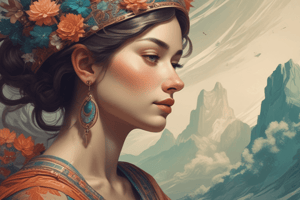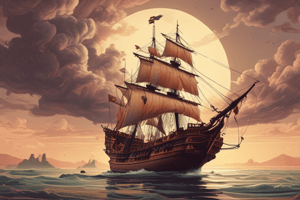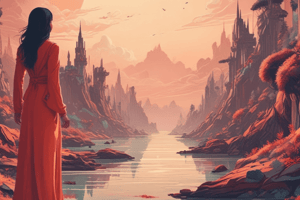Podcast
Questions and Answers
What type of surface is 2D visual art created on?
What type of surface is 2D visual art created on?
- Flat
- Three-dimensional
- Two-dimensional (correct)
- Round
Where did the history of 2D visual art originate?
Where did the history of 2D visual art originate?
- Ancient Rome
- Renaissance Europe
- Ancient Egypt, Mesopotamia, and Greece (correct)
- Modern America
What was a significant transformation in 2D visual art during the Renaissance?
What was a significant transformation in 2D visual art during the Renaissance?
- Increase in sculpture
- Use of abstract shapes
- Use of bold colors
- Shift towards more realism and perspective (correct)
What art style is characterized by dramatic lighting and intense emotions?
What art style is characterized by dramatic lighting and intense emotions?
Which artist is known for using chiaroscuro?
Which artist is known for using chiaroscuro?
What art movement sought to capture the fleeting effects of light and color?
What art movement sought to capture the fleeting effects of light and color?
Who is an example of an Impressionist artist?
Who is an example of an Impressionist artist?
What is an example of early 2D art?
What is an example of early 2D art?
What art movement broke down subjects into geometric shapes?
What art movement broke down subjects into geometric shapes?
What type of art emerged in the 1950s and 1960s?
What type of art emerged in the 1950s and 1960s?
What is one way 2D visual art serves as a powerful means of communication?
What is one way 2D visual art serves as a powerful means of communication?
What does 2D visual art reflect?
What does 2D visual art reflect?
What does 2D visual art preserve?
What does 2D visual art preserve?
What does engaging with 2D visual art often lead to?
What does engaging with 2D visual art often lead to?
What is an impact of 2D visual art on individuals?
What is an impact of 2D visual art on individuals?
What aspect of society does 2D visual art often challenge?
What aspect of society does 2D visual art often challenge?
What is a role of 2D visual art in society?
What is a role of 2D visual art in society?
What can 2D visual art inspire in individuals?
What can 2D visual art inspire in individuals?
What is one of the ways that 2D visual art contributes to the economy?
What is one of the ways that 2D visual art contributes to the economy?
What is a characteristic of medieval art?
What is a characteristic of medieval art?
What is a key feature of Renaissance art?
What is a key feature of Renaissance art?
What is a characteristic of Baroque art?
What is a characteristic of Baroque art?
What is a key feature of Impressionist art?
What is a key feature of Impressionist art?
What is one way that 2D visual art inspires other forms of artistic expression?
What is one way that 2D visual art inspires other forms of artistic expression?
What is a role that 2D visual art plays in society?
What is a role that 2D visual art plays in society?
When did the earliest forms of 2D visual art emerge?
When did the earliest forms of 2D visual art emerge?
What is a characteristic of classical art?
What is a characteristic of classical art?
What is a benefit of engaging with and supporting 2D visual art?
What is a benefit of engaging with and supporting 2D visual art?
What is the primary goal of Expressionism?
What is the primary goal of Expressionism?
Which art style broke away from traditional representations of reality?
Which art style broke away from traditional representations of reality?
What is a characteristic of Abstract Expressionism?
What is a characteristic of Abstract Expressionism?
What is the main feature of Contemporary art?
What is the main feature of Contemporary art?
What is a key element of Classical art?
What is a key element of Classical art?
Who are some famous Expressionist artists?
Who are some famous Expressionist artists?
What is a characteristic of Cubist art?
What is a characteristic of Cubist art?
What is the focus of Abstract Expressionist artists?
What is the focus of Abstract Expressionist artists?
What is a characteristic of Contemporary art?
What is a characteristic of Contemporary art?
What is a key element of Classical art?
What is a key element of Classical art?
Who are some famous Contemporary artists?
Who are some famous Contemporary artists?
What does traditional art often reflect?
What does traditional art often reflect?
Which of the following is a key element of traditional art style?
Which of the following is a key element of traditional art style?
What type of scenes are often depicted in traditional art?
What type of scenes are often depicted in traditional art?
What is a characteristic of traditional art techniques?
What is a characteristic of traditional art techniques?
What is a common feature of traditional art?
What is a common feature of traditional art?
What influences traditional art styles?
What influences traditional art styles?
How does traditional art often evolve over time?
How does traditional art often evolve over time?
What is a key difference between classical and traditional art styles?
What is a key difference between classical and traditional art styles?
Flashcards are hidden until you start studying
Study Notes
Definition and History of 2D Visual Art
- 2D visual art is created on a two-dimensional surface, including paintings, drawings, prints, and photographs.
- The history of 2D visual art can be traced back to ancient civilizations, such as Egypt, Mesopotamia, and Greece, where it was used to tell stories, document historical events, and depict religious and mythological themes.
Origins of 2D Visual Art
- Examples of early 2D art can be found in cave paintings, hieroglyphics, and pottery.
- During the Renaissance period in Europe (14th to 17th centuries), 2D visual art experienced a significant transformation, with artists like Leonardo da Vinci, Michelangelo, and Raphael achieving great heights in their art.
Development of 2D Visual Art Styles
- Baroque (17th to 18th centuries): characterized by dramatic lighting, intense emotions, and elaborate compositions.
- Impressionism (19th century): revolutionized the art world by capturing the fleeting effects of light and color, with artists like Claude Monet, Edgar Degas, and Pierre-Auguste Renoir.
- Cubism (early 20th century): broke down the subject matter into geometric shapes, fragmenting and reassembling it from multiple viewpoints, led by artists like Pablo Picasso and Georges Braque.
- Pop Art (1950s and 1960s): challenged traditional notions of what constituted high art, incorporating everyday objects and images from advertising and popular media, with artists like Andy Warhol and Roy Lichtenstein.
Contemporary 2D Visual Art
- In the present day, 2D visual art continues to evolve with the emergence of new mediums and technologies, such as digital art.
- Digital art allows artists to create works using computer software and tools, expanding the possibilities for 2D art.
Significance and Impact of 2D Visual Art in Society
- 2D visual art plays a vital role in society, influencing culture, stimulating emotions, and encouraging critical thinking.
- It serves as a powerful means of communication and expression, allowing artists to translate their thoughts, ideas, and emotions onto a flat surface.
Reflection of Culture and Society
- 2D visual art acts as a mirror reflecting the aspects of culture and society in which it is created.
- Artists often respond to and comment on social, political, and economic issues of their time, providing valuable insights into historical events, cultural values, and societal trends.
Preservation of History and Heritage
- 2D visual art offers us glimpses into the past, preserving historical moments, traditions, and human experiences.
- Artworks serve as visual records of a specific time and place, providing future generations with a deeper understanding of their heritage.
Emotional and Intellectual Engagement
- Engaging with 2D visual art can evoke a range of emotions and thoughts, leading to personal reflection and introspection.
- Artworks often challenge viewers to question their perspectives, encouraging critical thinking and fostering an appreciation for diverse forms of expression.
Inspiration and Economic Impact
- The beauty and creativity found in 2D visual art has the power to inspire individuals from all walks of life.
- 2D visual art has a significant economic impact, contributing to the growth of the creative industries, tourism, and local economies.
Evolution of 2D Visual Art Styles
- Ancient Art: cave paintings, depicted scenes of daily life, animals, and hunting, created over 40,000 years ago.
- Classical Art: refers to the art of ancient Greece and Rome, characterized by balance, harmony, and proportion.
- Medieval Art: emerged during the Middle Ages, characterized by religious themes, intricate manuscript illuminations, and stained glass windows.
- Renaissance Art: marked a significant shift in the art world, with artists focusing on creating realistic, three-dimensional artwork with perspective and depth.
- Baroque Art: developed as a reaction to the simplicity and restraint of Renaissance art, characterized by elaborate details, rich colors, and a sense of grandeur.
- Impressionism: emerged in the late 19th century, emphasizing the capture of fleeting effects of light and color.
- Expressionism: aims to express the emotional and psychological experiences of the artist, often distorting the subject matter to evoke a visceral response.
- Cubism: revolutionized the way artists perceived and represented reality, breaking down objects into geometric shapes and rearranging them on a two-dimensional surface.
- Abstract Expressionism: emerged in the mid-20th century, characterized by non-representational forms and spontaneous, energetic brushwork.
- Contemporary Art: encompasses a wide range of styles, techniques, and subject matter, with artists constantly pushing the boundaries of what art can be.
Overview of Classical and Traditional 2D Visual Art Styles
- Classical Art: emerged in ancient Greece and Rome, and later revived during the Renaissance period, characterized by harmony, balance, and idealized proportions.
- Traditional Art: encompasses a wide range of artistic movements and techniques, often associated with specific cultures, regions, or historical periods.
Key Elements of Classical and Traditional Styles
- Classical Art: idealized figures, realism, balanced composition, and narrative depiction.
- Traditional Art: cultural influence, depiction of nature and landscapes, handcrafted techniques, and symbolism and spirituality.
Influences on Classical and Traditional Styles
- Classical Art: drew influences from ancient Greek and Roman art, mythology, literature, and philosophy.
- Traditional Art: shaped by cultural and historical factors, incorporating elements from neighboring cultures or responding to societal changes.
Studying That Suits You
Use AI to generate personalized quizzes and flashcards to suit your learning preferences.




